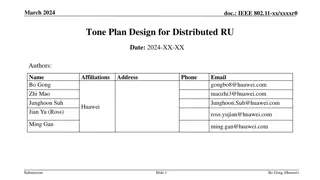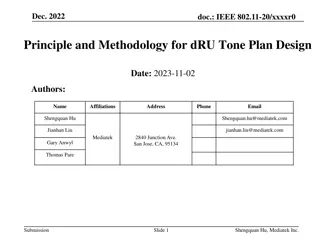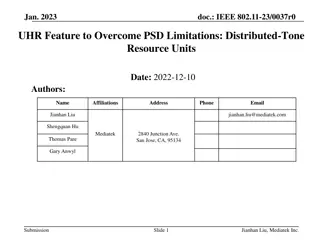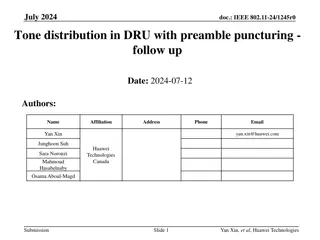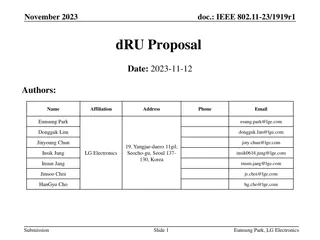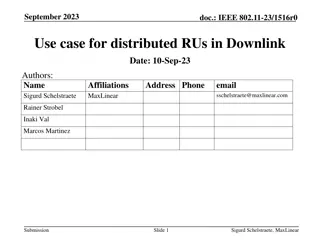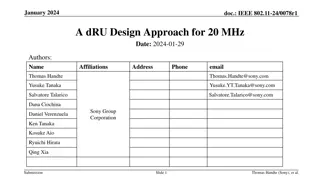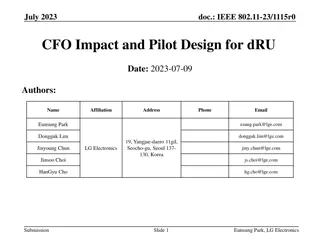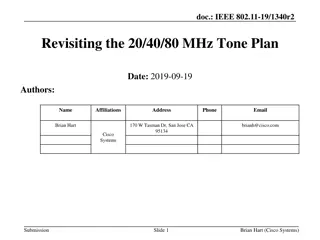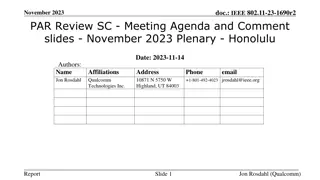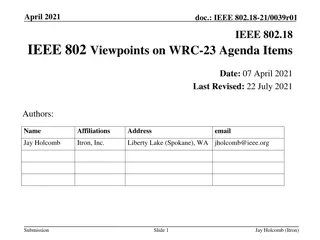High-Level Thoughts on Distributed Tone Resource Unit (dRU) Design in IEEE 802.11-23/1988r2 November 2023
Various aspects of Distributed Tone Resource Unit (dRU) design in IEEE 802.11-23/1988r2, such as PSD limitations, distributed transmission regulations, application areas, and open questions are discussed in this presentation by Lin Yang from Qualcomm. Topics include tone distribution, power pooling gain, spectral efficiency, support for different bandwidth capabilities, and more.
Download Presentation

Please find below an Image/Link to download the presentation.
The content on the website is provided AS IS for your information and personal use only. It may not be sold, licensed, or shared on other websites without obtaining consent from the author. Download presentation by click this link. If you encounter any issues during the download, it is possible that the publisher has removed the file from their server.
E N D
Presentation Transcript
doc.: IEEE 802.11-23/1988r2 November 2023 High Level Thoughts on DRU Design Date: 2023-11-xx Authors: Name Affiliations Address Phone Email Lin Yang Bin Tian Qualcomm Youhan Kim Qifan Chen Submission Slide 1 Lin Yang (Qualcomm)
doc.: IEEE 802.11-23/1988r2 November 2023 Introduction Many contributions [1]-[7] have proposed Distributed tone Resource Unit (dRU) for 11bn and discussed potential tone plan, pilot location, signaling, etc. Before discussing the detailed design options, it is better to first converge on high level directions on some topics of dRU design In this presentation we will share our thoughts and recommendations Submission Slide 2 Lin Yang (Qualcomm)
doc.: IEEE 802.11-23/1988r2 November 2023 PSD Limit and Distributed Transmission Regulations put limitations on PSD in Sub-7GHz. E.g., In 6GHz, for a non-AP STA in LPI bands, the PSD limit is -1dBm/MHz 10dBm/MHz PSD limit in 2.4GHz bands in EU/China/Japan/Korea Mitigation methods: spreading bandwidth for small RUs If spreading RU tones over 80MHz RU/26/52 can gain more than 11dB power Even RU484 can gain 2.69dB Power Gain of Distributed tone Transmission over Local Transmission (dB) Spreading BW -> 20MHz 40MHz 80MHz Assumption Tone distribution to max Tx power Assuming equal power per tone RU26 8.13 11.14 11.14 RU52 6.37 11.14 8.13 RU106 3.36 8.13 6.37 RU242 N/A 5.12 2.69 RU484 N/A 2.69 N/A Submission Slide 3 Lin Yang (Qualcomm)
doc.: IEEE 802.11-23/1988r2 November 2023 Where Should dRU Be Applied to Focus on TB PPDU using UL OFDMA which has significant power pooling gain Using distributed tone plan, each STA can improve its TX power by spreading to wide bandwidth Power pooling gain with good spectral efficiency Applies to all MCS DL OFDMA and MU-MIMO : no need to support due to lack of gain and additional complexity SU: needs further investigation but need to consider Already has DUP mode Preamble can't be tone distributed for backward compatibility Un-populated tones will be wasted if spread Submission Slide 4 Lin Yang (Qualcomm)
doc.: IEEE 802.11-23/1988r2 November 2023 High Level Discussion on dRU Design Some open questions Spreading BW: 80MHz or higher Mixture of distributed RU (dRU) and regular RU (rRU) Supporting RU/MRU set Support of puncturing Support of STA with different BW capability in wide bandwidth OFDMA 20MHz operating STA 80/160MHz operating STA Submission Slide 5 Lin Yang (Qualcomm)
doc.: IEEE 802.11-23/1988r2 November 2023 dRU Spreading BW For 20/40/80MHz PPDU BW, it is reasonable for all dRUs to spread to PPDU BW For PPDU BW>80MHz, still recommend to limit dRU spreading BW to 80MHz due to the following reasons Not all devices support larger than 80MHz Spreading over 80MHz can already harvest majority of power gains Need changes to segment parser and existing per 80MHz processing flow if spreading beyond 80MHz For dRU size > RU996, if perform per 80MHz segment spreading, there is also complexity on scheduling and power allocation For example, for MRU996+484 in 160MHz OFDMA transmission, if RU996 and RU484 each spread over its 80MHz, then per tone power will be different Overall to balance the complexity and gain, suggest to limit the spreading BW to 80MHz, and dRU size <RU996 Submission Slide 6 Lin Yang (Qualcomm)
doc.: IEEE 802.11-23/1988r2 November 2023 Mixture of dRU and rRU For 20/40/80MHz PPDU, mixture of dRU + rRU is not preferred More complicated in scheduling, tone plan, signaling and AP receive processing dRU can spread over entire PPDU BW to max Tx power For 160/320MHz PPDU, hybrid mode can be supported with limited flexibility to reduce scheduling and signaling complexity Propose per 80MHz decision: each 80MHz segment can use either dRU or rRU but no mixture If 80MHz segment uses dRU, then the spreading BW is 80MHz unless there is a puncturing If 80MHz segment uses rRU, minimal RU size is RU242 Submission Slide 7 Lin Yang (Qualcomm)
doc.: IEEE 802.11-23/1988r2 November 2023 Support of RU/MRU<996 Tones dRU26 support dRU26 needs to be supported for 20 MHz and 40 MHz PPDU For 80MHz PPDU, dRU26 can be transmitted only up to 13dBm. Well using dRU52 the Tx power can be 16dBm, no much benefit to schedule dRU26 in 80MHz Not to support of MRU52+26 and MRU106+26 in dRU Supporting MRU with center RU26 will further complicate the dRU tone plan design Marginally useful Only supports the most useful modes to reduce implementation/testing complexity Prefer BW dependent dRU size supportto maximize BW and power efficiency 20MHz: RU26, RU52, RU106 40MHz: RU26, RU52, RU106, RU242 80MHz: RU52, RU106, RU242, RU484 Submission Slide 8 Lin Yang (Qualcomm)
doc.: IEEE 802.11-23/1988r2 November 2023 Supporting BW Puncture Puncture brings another complexity to dRU design, need to balance the complexity/flexibility/gain No puncture needs to be supported for 20/40MHz PPDU For 20MHz PPDUs, the distributing BW is 20MHz only For 40MHz PPDUs, the distributing BW is 40MHz only For 80MHz and above, dRU and puncturing decision can be done per 80MHz segment If puncture occurs in 80MHz subblock, can leverage tone plan design for 20MHz and 40MHz spreading BW E.g., 20MHz punctured in 80MHz, one or multiple RUs spread over 20 MHz, another one or group of RUs spread over remaining 40MHz To avoid the need of new tone plan for 60MHz Submission Slide 9 Lin Yang (Qualcomm)
doc.: IEEE 802.11-23/1988r2 November 2023 Supporting STA in wide BW OFDMA Mainly the following two cases 20MHz operation STA in 40, 80, 160, 320MHz 80/160MHz operation STA in 160, 320MHz 80/160MHz operation STAs fit well with the 80MHz spreading BW limit 20MHz operation STA in wide bandwidth OFDMA need some discussion 20MHz operation devices can only support spreading BW of 20MHz It is very challenge to support multiple spreading BWs in 40/80MHz Prefer 20MHz operation STA support only in the following dRU modes PPDU BW of 20MHz In punctured 80MHz subblock where 20MHz spreading BW is used Submission Slide 10 Lin Yang (Qualcomm)
doc.: IEEE 802.11-23/1988r2 November 2023 dRU Tone Plan Design Philosophy Maximize power gain and spectral efficiency gain Given PSD limit (e.g., -1dBm/MHz), minimize the number of tones per 1MHz to maximize Tx power Spectral efficiency should not be worse than regular OFDMA transmission E.g, existing OFDMA mode can support 9 RU26 in 20MHz, dRU should be able to support the same Keep dRU tone mapping simple Keep hierarchical OFDMA tone plan and pilot structure Make even distribution as much as possible to ensure channel smoothing Submission Slide 11 Lin Yang (Qualcomm)
doc.: IEEE 802.11-23/1988r2 November 2023 Summary We discussed high level questions on dRU design Spreading BW limit prefer up to 80MHz Mixture of dRU and rRU no hybrid mode for up to 80MHz, per 80MHz dRU/rRU switch RU/MRU no MRU, prefer BW dependent RU size support BW puncturing Per 80MHz dRU and puncturing decision STA with different BW capability in wide bandwidth OFDMA using distributed tone plan Prefer support 20MHz operation STA only when spreading BW of 20MHz Briefly discussed dRU design criteria Max. power gain and efficiency gain Keep dRU tone mapping simple Submission Slide 12 Lin Yang (Qualcomm)
doc.: IEEE 802.11-23/1988r2 November 2023 References [1] 11-23-0037-00-0uhr-uhr-feature-to-overcome-psd-limitations- distributed-tone-resource-units [2] 11-23-0281-00-0uhr-considerations-on-ru-mru-designs-for-uhr [3] 11-23-1117-00-0uhr-dru-signaling-for-uhr [4] 11-23-1115-00-0uhr-cfo-impact-and-pilot-design-for-dru [5] 11-23-1447-00-0uhr-cfo-impact-and-pilot-design-for-dru-follow-up [6] 11-23-1448-00-0uhr-further-considerations-on-dru [7] 11-23-1511-01-0uhr-pilot-tone-allocation-and-other- considerations-of-tone-distributed-rus-for-uhr Submission Slide 13 Lin Yang (Qualcomm)
doc.: IEEE 802.11-23/1988r2 November 2023 Straw Poll #1 Do you agree to include the following text to the 11bn SFD: 11bn will define distributed tone RU ( DRU ) transmission Submission Slide 14 Lin Yang (Qualcomm)
doc.: IEEE 802.11-23/1988r2 November 2023 Straw Poll #2 Do you agree that 11bn UL OFDMA supports distributed tone RUs (dRU) in UHR TB PPDU? Submission Slide 15 Lin Yang (Qualcomm)
doc.: IEEE 802.11-23/1988r2 November 2023 Straw Poll #3 Do you agree that the allowed spreading BWs of an dRU are 20MHz, 40MHz and 80MHz? 160MHz (TBD), needs further discussion Submission Slide 16 Lin Yang (Qualcomm)
doc.: IEEE 802.11-23/1988r2 November 2023 Straw Poll #4 Do you agree the following BW dependent dRU size support to maximize BW and power efficiency? No MRU in distributed transmission 20MHz: RU26, RU52, RU106 40MHz: RU26, RU52, RU106, RU242 80MHz: RU52, RU106, RU242, RU484 Submission Slide 17 Lin Yang (Qualcomm)
doc.: IEEE 802.11-23/1988r2 November 2023 Straw Poll #5 Do you support no hybrid dRU (distributed tone RU) and rRU (regular RU) mode for up to 80MHz and allowing per 80MHz dRU/rRU switch if PPDU BW >80MHz? Submission Slide 18 Lin Yang (Qualcomm)
doc.: IEEE 802.11-23/1988r2 November 2023 Straw Poll #6 Do you agree that in a punctured 80MHz subblock, the only allowed spreading BWs are 20MHz and 40MHz? Submission Slide 19 Lin Yang (Qualcomm)


